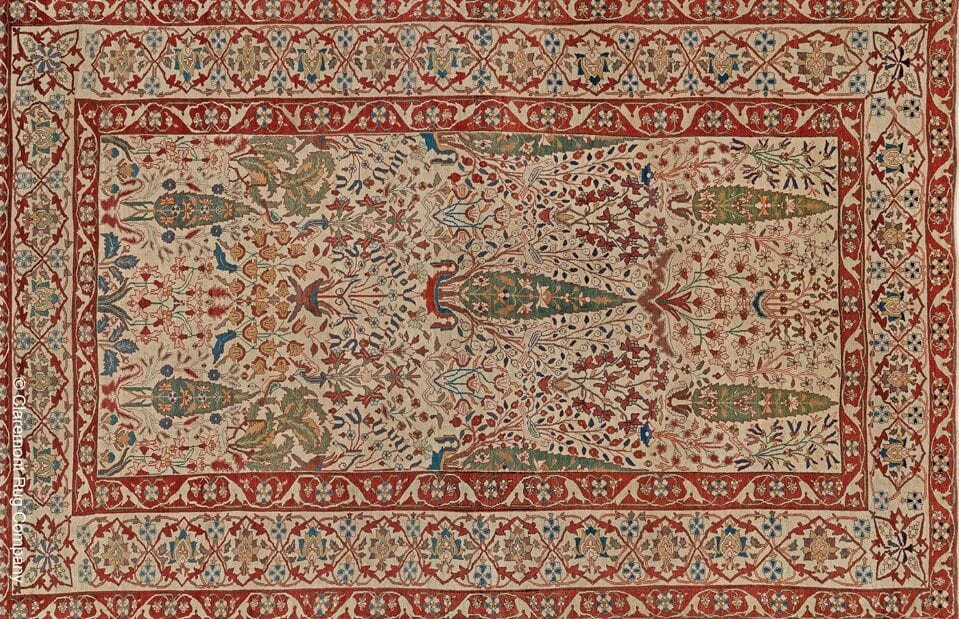21 Feb World’s Most Famous Tradition of Persian Carpets
Persian Carpets: There is something about the Persian carpet that makes it the most potent and symbolic of all textiles. Of course, it’s just a floor covering, so why has it made its way into art, poetry, music, and fashion?
Delving into the history and the marvelous workmanship may answer these questions.
The history of the Persian carpet goes back at least 2500 years to the time Xerxes was ruling. This is proven by the existence of the Pazyryk carpet, discovered in Kazakhstan in the 1940s and dated to this time. The motifs on this carpet are similar to those found in Persepolis, the ancient capital of Persia. Several great Persia rulers, such as Cyrus the Great, played their part by giving extensive patronage to the industry. The coming of the Seljuk Turks to Persia brought the Turkish knot to the region, still used in certain areas. Carpets became more and more complex, reaching a culmination in the Safavid period. The whole industry became formalized, with centers of weaving such as Tabriz and Kerman giving their name to particular styles, a practice still followed.



Made initially for a nomadic lifestyle, Persian carpets over time became highly elaborate, with a language of color and recurring motifs all their own. The existence of the Silk Route and the sea routes discovered by Vasco Da Gama ensured that the carpets were traded to the western world, a trade that only grew with time.
ABOUT SILK ROUTE, THE PRIMARY GOODS OR IDEAS TRADED, AND HISTORICAL IMPACT
HISTORIC DESIGN MOTIFS, THE HISTORY, CULTURE AND ANTHROPOLOGY, AND RELEVANCE TO CRAFT
WORLD’S MOST FAMOUS CARPET TRADITIONS FROM KASHMIR AND AGRA
Let’s look briefly at the process of creating a Persian Carpet.
Carpets are generally made from sheep’s wool, and the quality can vary depending on the breed and pasture. The yarn is threaded by hand and then dyed, using natural sources like madder, indigo, chamomile, and pomegranate.
The weaving process can take up to a few years, depending on the complexity of the carpet. The carpets follow the knotting method, and knowledge of this is passed down through generations. The pattern is initially laid out in a ‘cartoon’ and the weavers follow this as a guide. Most rugs are perfectly symmetrical, regardless of the direction.
Finally, the carpet is washed and finished.


There is a beautiful philosophy involved in the weaving, which is known as the Persian Flaw. Weavers intentionally weave in a fault so that no carpet is perfect, the thought being that only God can create perfection, and no mortal can aspire to it.
Motifs in Persian Carpets
While each carpet is unique and often expresses something personal about the weaver, some motifs run through Persian rugs, many with an ancient history attached to their use.
The Boteh or Paisley is the most famous and can be interpreted as a pine cone, a teardrop, or fruit/tree. It is most often found in an all-over pattern.
The Gul or flower appears in all combinations, repeats, and octagonal.
The Mina Khani refers to a repeat of daisies, almost always found in all-over patterns.
The central medallion appears in all combinations.
The palmette is found in borders as well as all over designs.
My personal favorite is the Cypress, often appearing as a central motif.



The layout of Persian Carpets
All over carpets are covered in a combination of motifs.
Vase design carpets often have a central vase in the layout.
And the most famous of all: the pictorial carpets, which often tell a story like Shirin and Khusrow. The Mashahir carpets are the rarest under this head, which shows recognizable faces of noblemen and royalty, created by the finest craftsmen and with the highest number of knots.




Persian Carpets in Popular Culture
Many paintings by master artists depict carpets, such as Vermeer’s Young woman with a Water Pitcher. Even today, artists are entranced by their beauty, some only painting carpets in their styles.


Fashion has been deeply influenced: witness the Tabriz collection 2013 by Hermes, or Alexander McQueen A/W 2017.


Several famous rock bands like CSNY and Eric Clapton have hosted concerts, where the stage is covered in Persian carpets.
Currently, the carpet industry in Iran is threatened by cheap factory-made carpets from China and India, which have done away with the hand-knotting process and the use of natural dyes. The unrest in Iran has only added to the problem. It is up to us and future generations to keep this priceless legacy alive and going.
AUTHOR BIO
Mira Gupta is a well-known curator and designer in craft-based luxury. She has had working stints with Fabindia, Good Earth, and Ogaan to promote the cause of craft. She is deeply interested in art, travel, architecture, and culture.
Read more articles by the Author HERE




Manina Baumann
Posted at 21:27h, 25 FebruarySuch a beautiful collection of carpets.
Lindie Ward
Posted at 07:26h, 01 AprilI enjoy your articles very much, Manina.
Would you say that Persian textiles and rugs are more likely to depict the Tree of Life as a tree with many different flowers and creatures around it, as though it is the source?
I have noticed that Indian textiles and rugs often show just one flower or fruit represented in the tree.
Perhaps this indicates which market the goods were destined for.?
What is your opinion?